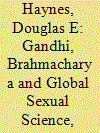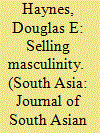| Srl | Item |
| 1 |
ID:
177198


|
|
|
|
|
| Summary/Abstract |
This essay explores the evolution of Gandhi’s philosophy of brahmacharya (celibacy) after World War I. I argue here that Gandhi broadened his understanding of brahmacharya after he assumed leadership of the nationalist movement, rendering it into a concept that was applicable to the wider population of India rather than just to himself and a set of especially disciplined activists. A major reason for this development was Gandhi’s concern with deflating the claims of sexual science and birth control at a time when global sexology was gaining a foothold in Indian middle-class society. In this context, Gandhi specifically came to contest the notion that human ‘nature’ made brahmacharya inapplicable to ordinary people, suggested that husbands and wives could follow brahmacharya even while married, and insisted that the general practice of brahmacharya was essential to the collective health of the Indian nation. In the process, he imparted a significant eugenic component into his philosophy.
|
|
|
|
|
|
|
|
|
|
|
|
|
|
|
|
| 2 |
ID:
116078


|
|
|
|
|
| Publication |
2012.
|
| Summary/Abstract |
This essay discusses advertising for sex tonics in Western Indian newspapers between 1900 and 1945. It specifically focuses on the emergence of a new paradigm of tonic advertisement-the marital happiness advertisment-after 1935. Arguing that tonic advertisers always sought to develop appeals grounded in prevously circulating conceptions of sexuality and the body, it first examines pre-1935 forms of advertisement submitted by local businesses and global corporations. It then turns to discussion of the marital happiness ads, which stress the modern husband's need to satisfy his wife sexually, demonstrating that this trope was strongly influenced by the development of global sexology. These ads, however, resorted to a hybrid reasoning, which also included the kinds of logic found in earlier advertisements, especially those about 'semen anxiety'.
|
|
|
|
|
|
|
|
|
|
|
|
|
|
|
|